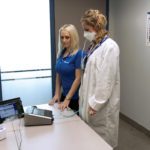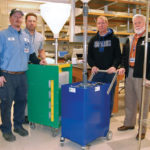Archive for 2021
Data Analytics and Gas Monitoring: Breaking Down Big Data to Identify & Mitigate Health & Safety Risks
Igor Avlijas, P.Eng, Contributor As most personnel return to the workplace full-time, industrial hygienists face the growing and continued challenge of mitigating gas and other hazardous exposures that result in both acute and long-term health effects. Whether it’s in oil & gas, construction, manufacturing or other industries, the threat of harmful substances, such as carbon…
Read MoreChemRest Know You’re Protected
Selecting the right chemical resistant glove for the job is obviously complicated. In this IHW exclusive interview with Gilbert LeVerne, Jr., Director, Marketing at SHOWA International, we discussed a wide range of issues that can help protect workers from chemical burns, including the company’s Chemical Resistant Glove Directory. Q: Employees where chemicals are manufactured are…
Read MoreConsider This: Choosing the Right Hearing Protection
By: Kari Buchanan, M.P.H., M.A., Industrial Hygienist & National Hearing Conservation Association Expert Hearing protection devices (HPDs) vary in their ability to attenuate noise. Several factors should be considered when selecting hearing protectors for specific settings and tasks. How much protection is needed? What is the characterization of the noise exposure? Is speech communication or…
Read MoreMaintain Injury-Free Jobsites Through Digital Compliance Processes
By: Travis Parigi, Contributor Many employers with field service teams have traditionally relied on the honor system for much of their safety and regulatory compliance. This can be a recipe for disaster that puts undue pressure on field technicians to take safety risks. For example, a worker sent to run wiring at a client’s remote…
Read MoreRespiratory Protection Program Management & Fit-Testing Update
By: Rob Brauch, COHC, Contributor Let’s start with the obvious—the worldwide response against COVID-19 has impacted just about every facet of our daily lives. At first, there was conflicting information about how the disease was passed from person-to-person and what the death tally might become if the disease was left unchecked. Meanwhile, governments and the…
Read MoreFour Problems Lone Workers Face and How to Solve Them
By: Ryan Cantwell, Contributor By the time you finish reading this sentence, a person will have been hurt at work. By the time you sit down for dinner with your family, more than 14 people will have died on the job, leaving families and coworkers in mourning. As a professional in the safety industry, you…
Read MoreSolutions to Heat Stress for Workplace Safety
By: Jane Marsh, Contributor As average temperatures rise throughout the globe due to climate change, workplace safety is taking precedence. Employees who work in buildings without adequate ventilation or air conditioning; work outside in higher temperatures; or work in hot conditions are at a higher risk for heat-related illness. Employers are required to ensure their…
Read MoreThe OSHA Recordkeeping Advisor
By: Edward Stern, Contributor OSHA has a powerful, free tool to help employers (and employees) understand the Recordkeeping Rules. It is the OSHA Recordkeeping Advisor, available at https://webapps.dol.gov/elaws/osharecordkeeping.htm. Why is it needed? A good clue is the text of the first page of the Advisor. It says, “… The OSHA Recordkeeping Advisor is intended to…
Read MoreTesting of Showers & Eyewashes
By: David Withee, Contributor Test showers and eyewashes how often? Short answer: weekly. Middle answer: testing annually, activating weekly. Long answer: as often as needed to meet OSHA requirements and expectations for your circumstances. OSHA Standard 29 CFR 1910.151 (C) words it simply: “Where the eyes or body of any person may be exposed to…
Read MoreLimits for Air Contaminants: 1910 Subpart Z
By: Bob Henderson, Contributor “Federal and state regulations define the PEL for toxic contaminants, but do not specify how to set the alarms. Gas detection customers depend on manufacturers for guidance. The annotated Z-1 tables provide a side-by-side comparison that allows GfG to provide advice based on best practice as well as minimum requirements specified…
Read More











